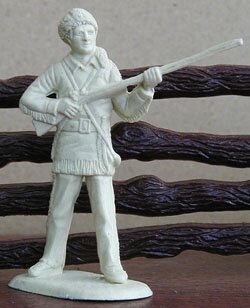Fort Dearborn Cavalrymen
PL-422
These cavalrymen -- also referred to as frontiersmen -- appeared in 1952 in Marx' first wild west playset, Fort Dearborn. They are commonly referred to as 45mm scale, but are closer to 50mm. Although noticeably smaller than the later 60mm and 54mm figures, they were included in many later playsets with the larger figures, including the first Fort Apache playset released in 1953, the first Davy Crocket at the Alamo playset in 1955, and even as late as 1963 in Custer's Last Stand. Us kids did not get upset about the difference in size, as long as we got plenty of cowboys and Indians!
The mold included two complete sets of the ten figures. The figures are most commonly found in silver, light tan, blue, and yellow colors, but were made in other colors also. They were originally made in vinyl and later in soft plastic. I have a deep yellow mounted figure in soft plastic that sure looks like an original to me. (see Pose 2 below).
As with many other early Marx wild west figures, the standing figures initially were made with no base to help them stand upright. Eventually, Marx added bases to all but one of them, after parents and kids complained that the baseless ones would not remain upright. Which one never got a base? Well, it was the Shot with Arrow pose (Pose 9). And why didn't it get a base? I have heard no story on that one, but my imagination tells me that the Marx logic went something like this: 1) every little bit of vinyl or plastic added to a figure costs money, 2) anybody with an arrow in his side is naturally going to fall down, and 3) why waste money to keep a guy on his feet when he should be falling down? Sounds good to me....
The figure set includes one of Marx' unsovled mysteries, the "standing with arms back" pose (Pose 10). No one has been able to satisfactorily explain what this pose is intended to represent. His arms are pulled back and his fists clenched, and some collectors have claimed that at least some of these figures have what looks like rope molded onto their arms. Therefore, some suggest that it is intended to be a captured cavalryman who has been tied to an upright stake by the Indians. I like to think that this theory is supported by my little sister's recent comment that the bulge in his shirt above his waist makes it obvious that a rope or other restraint should be tied around his waist. But notably, no upright stake to lash him to was included in any of the wild west playsets. He does happen to fit such a stake included in Marx jungle playsets issued several years later, but it seems incredible that the company would make an accessory for a specific figure, yet never include the two in the same playset.
Frank Rice, the Chief Designer of Marx playsets, vaguely recalls that the figure may have been intended to be jumping off a roof onto a wagon or an enemy soldier and, moreover, that if he was to be tied to a stake, the rope would have been molded around his chest and waist. A few years ago, PFPC Editor Tom Terry suggested that the figure fits perfectly with the "crawling with tomahawk" Indian (see Pose 10 in the following section on Fort Dearborn Indians). This theory cleverly explains that the cavalryman is lying on his back, while the Indian is atop him, ready to do him in with the tomahawk. This seems and actually looks reasonable when the figures are placed together, but Marx eventually issued the cavalryman with a base, negating the idea that he should be lying down. Or did whoever added the base not realize that the poor guy was supposed to be lying down? Hmmm....
My personal favorite in this group is the cavalryman who has run out of ammunition (Pose 6) and has resorted to hand-to-hand combat with the playset's Indian trying to stab some unlucky opponent (see Pose 7 in the following section on Fort Dearborn Indians). Their intended action -- perhaps Marx' earliest example of figues made to interact with one another -- is most obvious when using the early figures with smaller bases. Collector Dave Lewis has provided the following photos of the two figures with smaller bases, locked in mortal combat.
 |
 |
| Cavalryman and Indian in hand-to-hand combat Photos provided by collector Dave Lewis |
|
Although I have not often run into them, re-issues of these figures have been made in Mexico. They can be found in both hard and soft plastic, in bright colors.
Click here to see horses related to these figures.
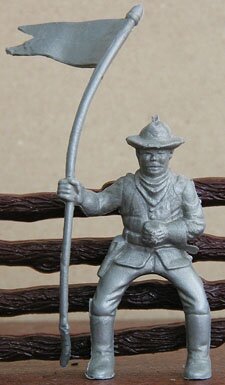 |
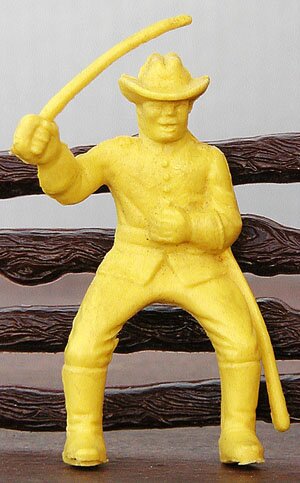 |
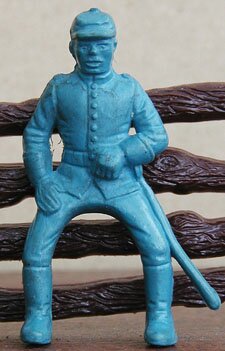 |
| 1. Mounted with flag | 2. Mounted with sword | 3. Mounted |
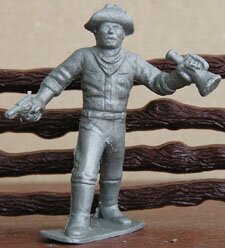 |
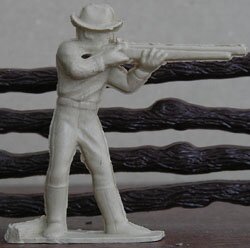 |
| 4. Bugler | 5. Firing rifle |
 |
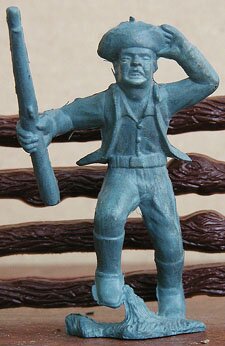 |
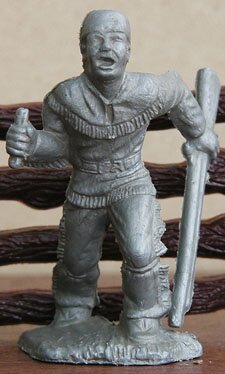 |
| 6. Fighting, using pistol as club | 7. Running, rifle right | 8. Running, rifle left |
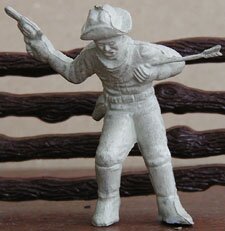 |
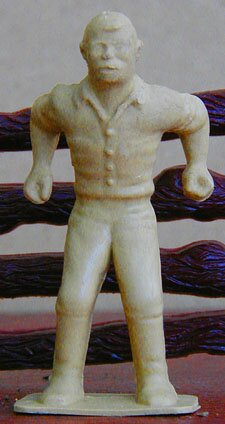 |
| 9. Shot with arrow | 10. Standing, arms back |
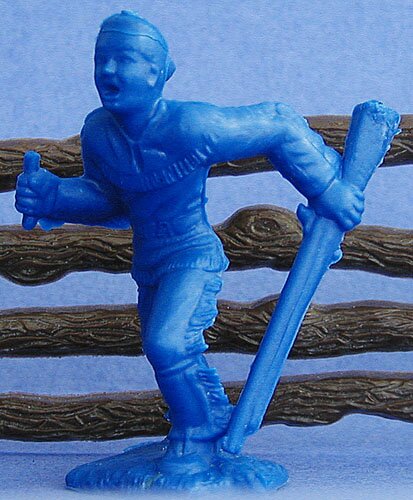
At right is a re-issue of Pose 8 above. While rather well made, the figure is in a harder plastic than used by Marx and a dark blue that Marx never used to make the Fort Dearborn cavalry figures. Although I do not often see them, re-issues of these figures have been made in Mexico. They can be found in both hard and soft plastic, usually in bright colors. See an example of other such figures at the end of the next section on Fort Dearborn Indians.

Fort Dearborn Indians
PL-443
As with Fort Dearborn cavalrymen in the previous section, these 45mm (actually 50mm, as are the Fort Dearborn cavalrymen above) Indians were first issued in 1952 with the Fort Dearborn Playset. Similarly, they were included in many other playsets later. The original mold included two complete sets of 12 poses. A 13th pose was added some time later.
Two Indians in the group have stories behind them. The kneeling Indian with one hand over his head (Pose 10) was initially intended to be paddling a canoe. Late in production, Marx decided that including a canoe with each playset would be too expensive. The mold was revised to remove the paddle, and the figure became a drum beater. This is an accepted story, and figures are occasionally found with a portion of the paddle. However, I find it odd that if the paddle was removed because the playset did not include a canoe, why didn't Marx add a small drum to the playset for the drum beater to use? Drums were not added to playsets until several years later when Marx increased its "piece count" by adding accessory sprues.
The Indian holding a scalp overhead (Pose 13), who was not originally included in the group, is also a bit of a mystery. The figure is commonly missing from groups of Fort Dearborn Indians up for sale. It was extremely rare until large numbers of the figure were discovered in Marx warehouses after the company went bankrupt. One legend has it that Marx removed the figure from playsets when parents claimed that it was too violent. As often is the case, the legend is not true. The figure was never included in Fort Dearborn or Fort Apache playsets and, in fact, was not produced until 1957. When the mold was modified to include this new figure, four poses were eliminated: the squaw, the Indian climbing a ladder, the drummer/paddler, and unfortunately the mounted Indian firing a rifle.
Actually, the figure was available only in 1957 and 1958 and only from two sources: The Lone Ranger Ranch playset and a Cheerios mail-in cereal premium. The short-lived Lone Ranger Ranch (1957-58) included the 45mm Indians, 54mm cowboys, and 60mm Lone Ranger character figures. The 1957 cereal premium cost 50 cents and included 22 figures: eight 45mm yellow Indians including the scalp pose, nine 54mm cowboys in a unique dark brown, three 54mm horses, and the 54mm mounted Lone Ranger and Tonto from PL-922 that could be obtained no where else. Oh, those missed opportunites! Cheerios cereal boxes provided five punch-out Western town buildings. As a result, the Indian with the scalp was very hard to find...until Marx closed it doors and wealthy collectors found the hoard of unsold stock.
My first contact with this group of Indians was when I purchased a Davy Crockett at the Alamo Playset from Kresge's Five and Dime in Lawton, Oklahoma. When Marx rushed out its first Alamo sets in 1955, apparently neither the new Alamo frontiermen nor the Mexican soldiers were ready to go. So the company put in the Fort Dearborn cavalrymen to defend the Alamo and the Indians to serve as the enemy. When the kid next door bought a set, I was floored by the Indian rider firing his rifle straight ahead (Pose 3). It was the coolest playset figure I had ever seen. I rushed out to purchase my own set...which, alas, was missing that figure. Crushed, I traded a pot full of figures to my neighbor for his Indian rider. Today I own four of the riders, each in a different color, and I am sure each one cost me more than my original purchase of the entire set fifty years earlier! But I am a happy kid...I mean man!
As noted above in the above section on Fort Dearborn cavalrymen, re-issues of these figures have been made in Mexico. An example of these figures is shown in the final photo below. Several clues show these to be re-issues: the figures are in bright shiny colors (color is not quite right in the photo), some of the figures are hard plastic, Marx never used the bright green or black in its wild west figures, and the figures do not have the two small circular depressions found on the bottom of the bases on most Marx figures. (My understanding is that these depressions were created in the Marx process of removing the figures from their mold.) Also shown are re-issued "drum beaters" with paddles;" I understand these have been made using the original mold with the paddle part of the mold re-opened.
Click here to see horses related to these figures.
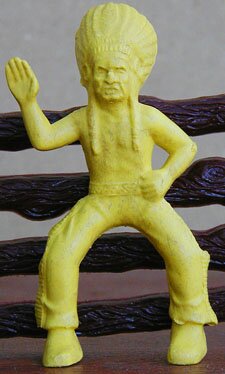 |
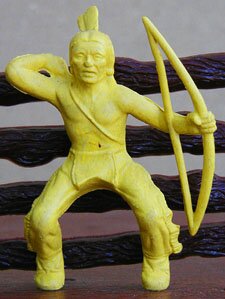 |
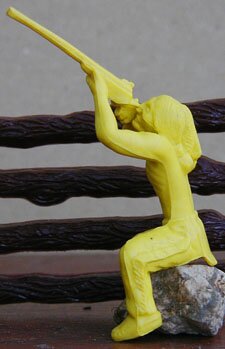 |
| 1. Mounted, right arm raised | 2. Mounted, drawing arrow | 3. Mounted, firing rifle |
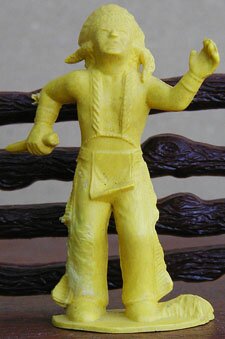 |
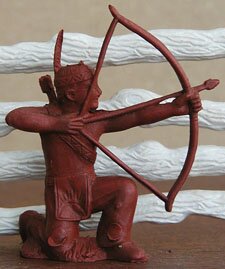 |
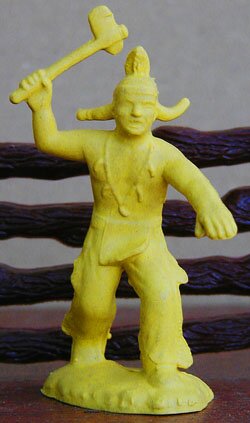 |
| 4. Standing, looking upward | 5. Kneeling, shooting bow | 6. Advancing with tomahawk |
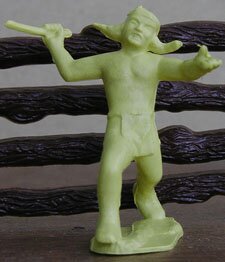 |
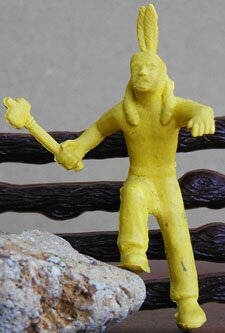 |
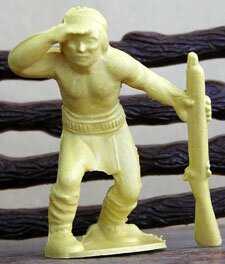 |
| 7. Fighting with knife | 8. Climbing ladder | 9. Scout with hand to head |
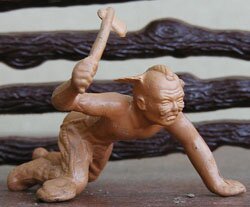 |
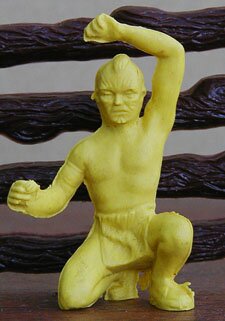 |
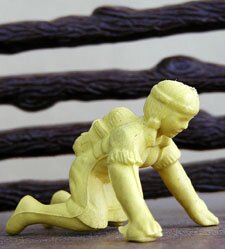 |
| 10. Crawling with tomahawk | 11. Beating drum | 12. Squaw |
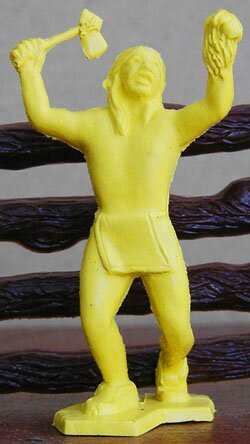 |
|
| 13. Standing, with scalp | |
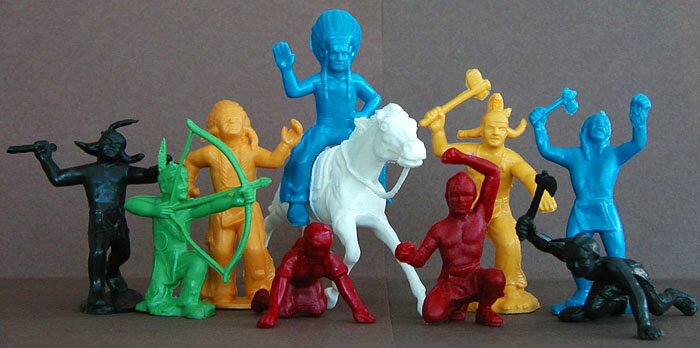 |
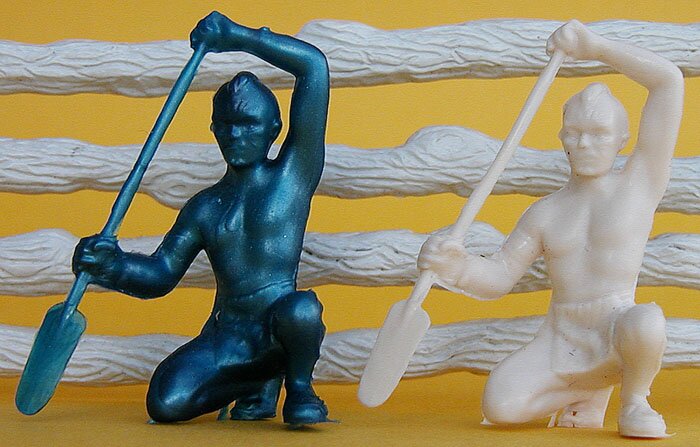 |
| These are examples of re-issued figures from Mexico. Some of these figures are hard plastic; others are soft plastic. The horse is also a re-issue, in hard plastic. | Two re-issue drummers with their paddles restored, as initially scuplted. |

45mm Rodeo Figures
Some time in the early 1950s, Marx apparently owned molds for a group of approximately 45mm scale rodeo cowboys and related animals. For some unknown reason, the company never produced or sold these figures. A few of the figures were moved to the mold for the 45mm cowboys described in the following section. In addition, a small number believed to have been manufactured by Marx exist today. These perhaps were from test runs of the molds. At the same time, several figures made from these molds have shown up in England and Mexico. Those from England include several cowboys and animals and appear to have been made in the 1950s. The Mexican figures were made much later and included only the animals. This figure group is discussed at length on Page 7 of this web site (along with photos of the entire group), and Playset Magazine Issue 45 includes a brief article on them. As noted in Playset Magazine, these figures are rare and individual figures have sold for more than $100.

45mm Cowboys
PL 398
This group of cowboys is one-half of what is the largest mystery among Marx wild west figures to me. The other half is the group of rodeo cowboys described in the 40mm Rodeo Figures on Page 6. These two groups appear to be somehow related, though we may never know exactly how.
Marx only included figures from the 45mm Cowboy group in two playsets: 1) its Cowboy and Indian Camp sold only in 1953 and 2) its Marxville Deluxe Western Ranch House, part of the compay's Marxville line of plastic buildings built for O-scale toy trains, which were sold from 1952 to 1954. The foot poses -- notably not the two mounted poses -- were also sold separately in bags. The figures were made originally in vinyl and later in soft plastic and are called 45mm scale, though I measure them to be between 38mm and 44mm from bottom of base to top of head or hat.. They are a bit more difficult to find than most Marx wild west figures, but are less popular than many, so most poses can be purchased in good condition in the $2 to $5 range.
The Cowboy and Indian Camp playset (#3949 and #3950) was sold by small market companies such as dime stores, not by the major catalog companies such as Sears and Wards. These play sets included 10 cowboys -- along with the 45mm Fort Dearborn Indians -- usually in a "tannish brown" vinyl, according to Playset Magazine Issue 2. Notably, Poses 9, 10, 11, and 14 below were not included in the playset featured in Playset Magazine. Like the Cowboy and Indian Camp playsets, the Marxville Ranch House sets contained 10 figures, but in cream, brown, or metallic blue. The cowboys sold in bags were a Christmasy red and green. Occasionally, you will find them in yellow.
So if there are 14 poses, why did the play sets include only 10? And therein lies a little mystery, a little research, and a possible explanation....
The research was done by play set figure expert Kent Sprecher, and you can read it in detail at his web site. However, I will attempt to summarize it here. This 45mm Cowboy group is apparently linked in some uncertain way to the group of rare rodeo figures described on Page 6. In PFPC Issue 69, another playset figure expert Rick Koch suggests that it was these rodeo figures that were first intended to be included with the Marxville Ranch House. For some reason that is not clear, the 45mm Cowboy group replaced them.
As to the 10 poses per playset, Kent Sprecher believes that the original 45mm Cowboy mold included two each of 10 poses: those shown below without Poses 9, 10, 11, and 14. When the Cowboy mold was first us
 ed, these four poses were part of the rodeo group mold. Therefore, each play set issued with this 45mm Cowboy group included the same 10 figures, including the two mounted poses. The contents of the Marxville Ranch House box are shown at right in a photo of a display at the Official Marx Museum in Moundsville, West Virginia.
ed, these four poses were part of the rodeo group mold. Therefore, each play set issued with this 45mm Cowboy group included the same 10 figures, including the two mounted poses. The contents of the Marxville Ranch House box are shown at right in a photo of a display at the Official Marx Museum in Moundsville, West Virginia. However, while playsets included Marx' 45mm horses, it is obvious to anyone who has seen the figures that the legs of the two mounted poses are not spread wide enough to fit properly onto these horses (see photo at right). On the other hand, they do fit perfectly onto horses that belong to the group of rodeo cowboys, but unfortunately those horses are a bit too small in scale for the 45mm Cowboy group and have serious problems in standing upright. Due to the rodeo horse problems, Marx could not use them to replace the 45mm horses. Therefore, according to Kent, Marx at some point very possibly removed the four mounted figures from the mold (two each of the two poses) and replaced them with four figures from the unused rodeo group mold, namely Poses 9, 10, 11, and 14 below.
After that change, playsets would not include the same 10 poses, because each would have only two of the four poses from the rodeo group. This would mean that Marx produced fewer of these poses -- and, of course, fewer of the mounted poses -- than the other eight poses. And Kent's experience -- as well as my own much lesser experience -- supports this theory, because these four poses and the mounted poses are the more difficult figures to find. In addition, Kent points out that he has never seen the two mounted poses in the later-used soft plastic or the four figures moved from the rodeo group in the earlier-used vinyl.
In addition, as with other figures, Marx had a problem with the 45mm Cowboys staying upright. So early production was made with smaller bases, and later production was made with larger bases. Kent's research indicates that vinyl figures were never made with the larger bases.
I find this all very interesting; however, we will never know for sure.
Oddly, because O-scale is approximately a 35mm scale, the figures are too large for the ranch house, so that their heads hover at attic-level. The ranch house itself -- which is also shown on Page 8 of this web site -- is better scaled for for the company's 35mm civilian figures (which include a farmer and his wife and a few animals).
All that said, I like these figures. They are semi-cartoonish, but are well-made and are tough to break. As such, they are a lot of fun and great for kids. Most of these figures can be found today with a little searching and patience.
Kent reports that that silver re-issues have been made in Mexico.
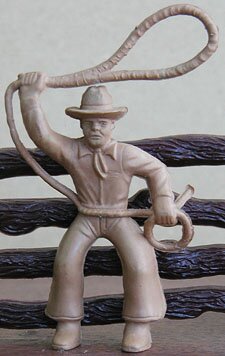 |
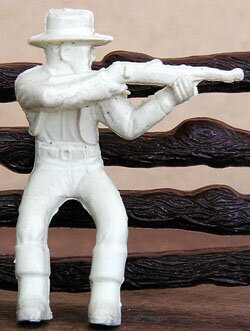 |
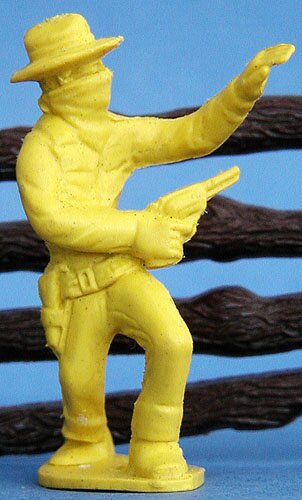 |
| 1. Mounted with lasso | 2. Mounted with rifle | 3. Bandit turned left, firing pistol |
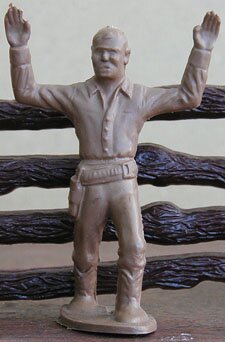 |
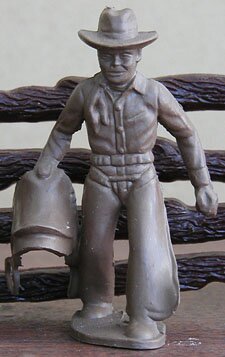 |
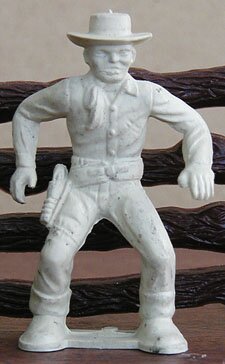 |
| 4. Outlaw, hands in air | 5. Carrying saddle | 6. Ready to draw |
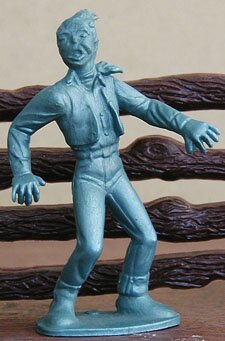 |
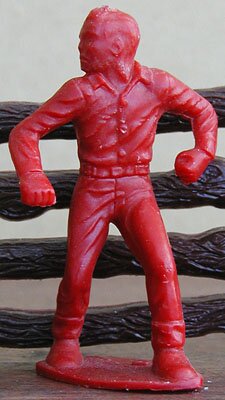 |
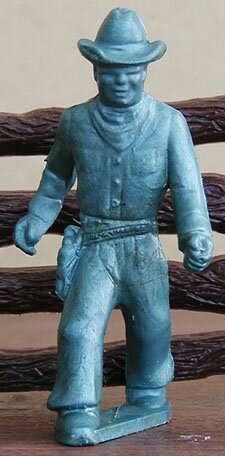 |
| 7. Taking a punch | 8. Throwing a punch | 9. Walking |
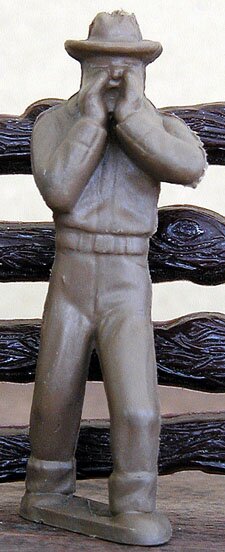 |
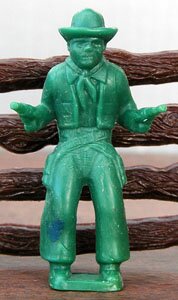 |
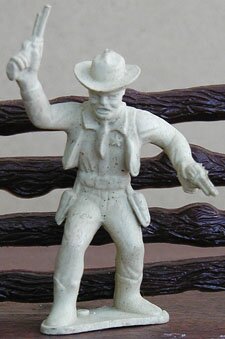 |
| 10. Calling | 11. Two pistols drawn at hips | 12. Sheriff, two pistols drawn |
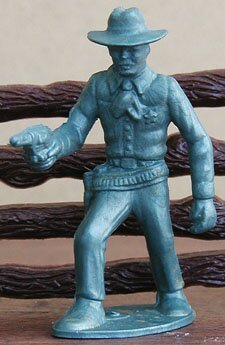 |
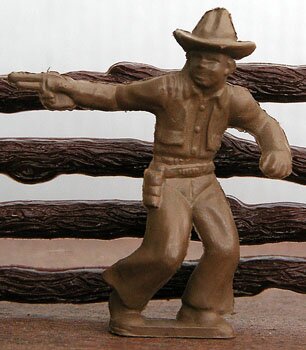 |
| 13. Sheriff, one pistol drawn | 14. Turned to right, shooting pistol |

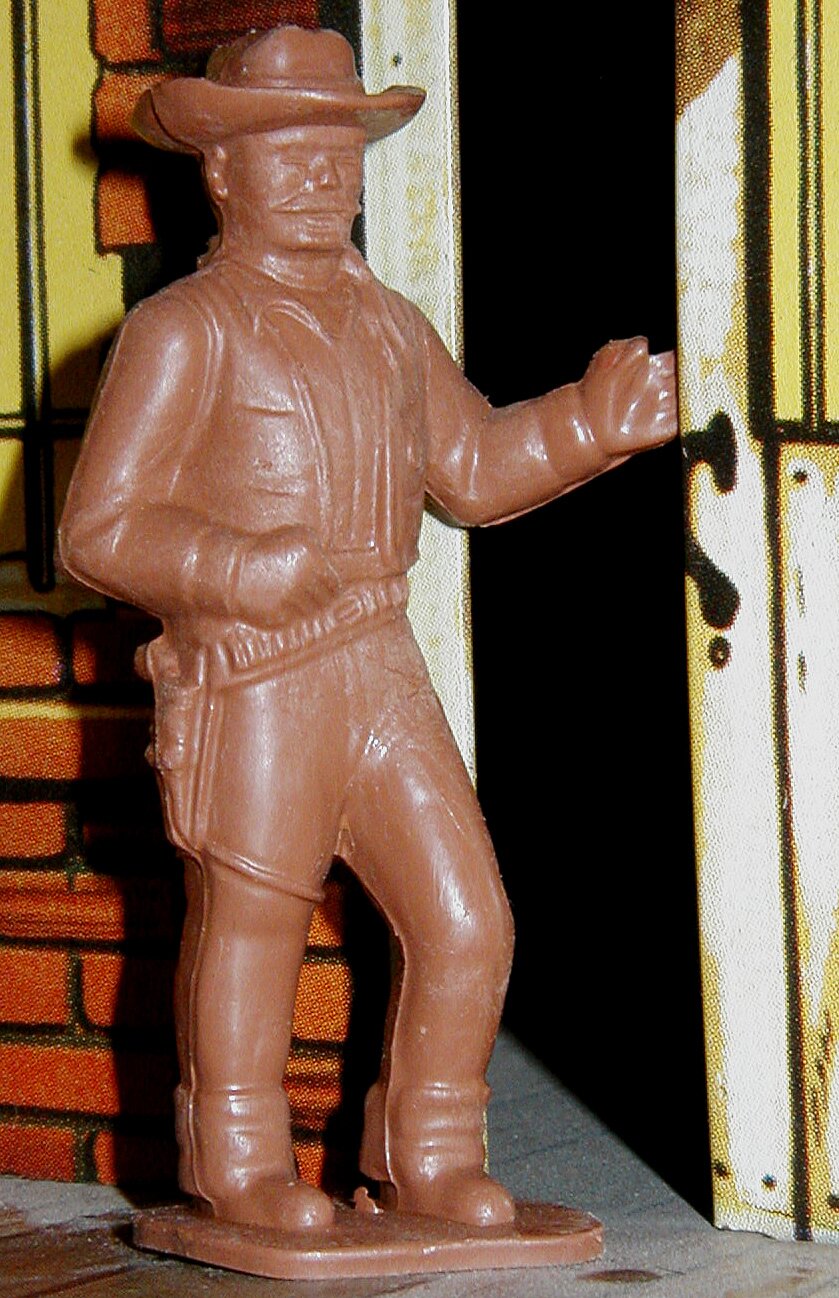
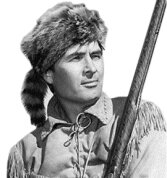 Marx began to produce its long-lasting line of Alamo playsets in 1955, and these playsets and the company's Alamo Frontiersmen are discussed with 54mm figures on Page 3 of this web site. However, the earliest Marx Alamo playsets came with the 45mm Fort Dearborn pioneers (see above), and that may be one reason that the early Alamo sets included a Davy Crockett figure in 45mm scale. The figure is inscribed on the bottom of its base as "Official Davy Crockett as Portrayed by Fess Parker." The figure was also found in some of the later Alamo playsets that included the 54mm Alamo Frontiersmen. Oddly, the figure was manufactured as part of a mold for Alamo Mexicans, PL-726A (see PL-726 on Page 3). According to Playset Magazine, PL-726A was used to make cream colored Mexicans, and PL-726 was used to make blue Mexicans. The Davy figure, as most Marx character figures, was cream.
Marx began to produce its long-lasting line of Alamo playsets in 1955, and these playsets and the company's Alamo Frontiersmen are discussed with 54mm figures on Page 3 of this web site. However, the earliest Marx Alamo playsets came with the 45mm Fort Dearborn pioneers (see above), and that may be one reason that the early Alamo sets included a Davy Crockett figure in 45mm scale. The figure is inscribed on the bottom of its base as "Official Davy Crockett as Portrayed by Fess Parker." The figure was also found in some of the later Alamo playsets that included the 54mm Alamo Frontiersmen. Oddly, the figure was manufactured as part of a mold for Alamo Mexicans, PL-726A (see PL-726 on Page 3). According to Playset Magazine, PL-726A was used to make cream colored Mexicans, and PL-726 was used to make blue Mexicans. The Davy figure, as most Marx character figures, was cream.